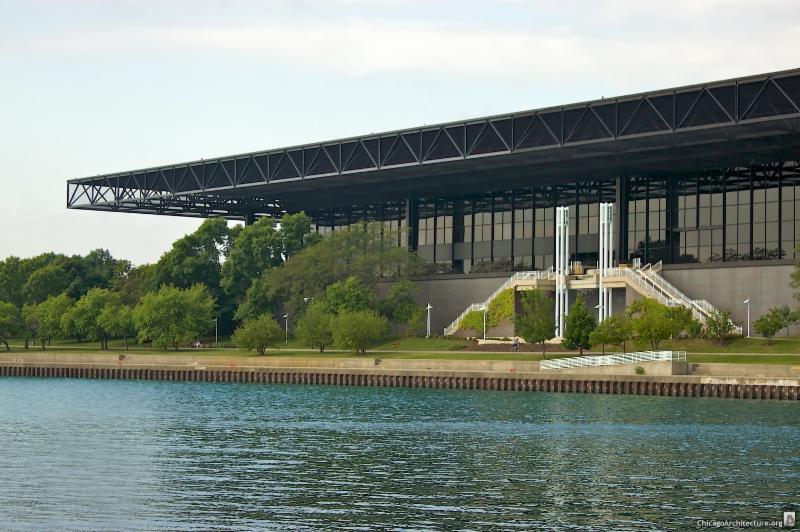



With little to no discussion, the Illinois State Senate approved an end-of-session bill that would allow the demolition of Lakeside Center at McCormick Place and the imposition of an expansive new $600 million tax on bars and restaurants and bars in dozens of Chicago neighborhoods. A flurry of media and social media attention brought this issue to light. Fortunately, Mayor Lori Lightfoot quickly released a statement to oppose the proposal prior to the bill being taken up by the Illinois House the following day where it was expected to pass. Exposed to light, the bill has been withdrawn. However, the Metropolitan Pier and Exposition Authority, the agency that oversees McCormick Place and Navy Pier, and its political allies perhaps plan to bring it up again in during the next session.
The loss of Lakeside Center would be tragic for Chicago. Lakeside Center is an extraordinary building by architecture firm C.F. Murphy and designers Gene Summers and Helmut Jahn, both acclaimed students of Ludwig Mies van der Rohe at Illinois Institute of Technology. In Lakeside Center they took Mies van der Rohe’s design principles and numerous design studies by Mies, his office and and his graduate students and applied them on an enormous, convention hall scale. The construction of Lakeside Center was an amazing feat and is on par with the City’s other superstructures of that period, specifically the John Hancock Building and the Sears Tower. However, unlike the vertically oriented Hancock, Sears and Standard Oil Buildings, Lakeside Center is a mammoth horizontal long-span structure. The result was a monumental architectural achievement for Chicago which helped to reinforce Chicago’s title of convention city with the largest roof, convention hall and space-frame structure in the world. The first McCormick Place was a windowless exposition hall dating from 1960, dubbed the “mistake on the lake,” was destroyed by fire in 1967. The current modernist steel and glass building was designed for the site and construction grand opening was held on January 3, 1971. The building has been featured in the book “Chicago’s Famous Buildings” in multiple editions by various editors and scholars over the past 50 years since its construction.
In addition to the building’s architectural significance, it presents a wonderful opportunity for a dynamic adaptive reuse that would return this prominent lakefront location to use by Chicagoans. The Lakeside Center could be easily retrofitted into a Mid-South Cultural Center and Field House and anchored by the Arie Crown Theater for cultural and community events. The cavernous space could accommodate a wide variety of first-rate facilities all under one roof. The upper levels of the center could be used for indoor tennis courts, running track, yoga, Zumba and weights, and other recreational uses overlooking Lake Michigan, harbors and parks. The expansive lower level halls could be used for an Olympic-sized swimming pool, basketball courts, climbing walls, squash courts, roller rink, roller derby track and perhaps even a bike velodrome track. The massive rooftop could be greened and activated for jogging path, tennis courts, and basketball courts. A café located at the northeast corner of the Lakeside Center rooftop would have such incredible panoramic views of the city and lakefront that it would likely become a must-see destination for locals and tourists alike.
The Lakeside Center as a Mid-South Cultural Center and Field House would be anchored by the Arie Crown Theater for cultural and community events. The Arie Crown Theater is one of the largest theaters in Chicago with seating for 4,250. Only the long-shuttered Uptown Theatre in Chicago’s Uptown neighborhood has a larger seating capacity. Additionally, the Arie Crown Theater has been well maintained with a significant renovation in 1997 which reduced the seating capacity, rebuilt the stage and improved the acoustics.
The building’s enormous terrace overlooking Lake Michigan is ideal for activation such as Chicago Summer Dance, music festivals and other outdoor activities under the broad overhang. The historic Humboldt Park Boat House is a great example of the type of successful programming that could activate and enliven this potentially extraordinary community resource.
Located along Chicago’s Lakefront Trail, the Mid-South Cultural Center and Field House would be easily accessible to joggers, bikers, rollerbladers and others from Ardmore Street on the North Side to 71st Street on the South Side.
Additionally, Lakeside Center is directly across a narrow channel from Northerly Island Park. Despite its large size and incredible location on a peninsula, this 120-acre park is difficult to access and suffers from low attendance and poor maintenance. A bike and pedestrian bridge could be built directly from Lakeside Center’s expansive terrace to increase access to this neglected Northerly Island Park.
The idea of demolishing a first-class building of great architectural and historical note would be a huge embarrassment for the City and another drain on Chicago’s taxpayers to fund another and bigger windowless convention center on Chicago’s Lakefront. Preservation Chicago applauds Mayor Lightfoot’s decision to slow down the process and encourages McPier, the Chicago Park District and other decision makers to find a creative way to better integrate the convention center into the daily fabric of Chicagoan. The Mid-South Cultural Center and Field House would accomplish this.


